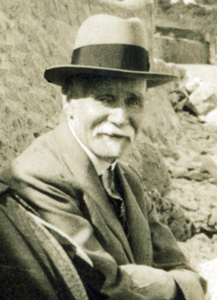
HENRY J CRAVEN, Racket Designer - Maker - Stringer
HISTORY
Henry Joseph Craven was born on 16th April 1854 in Wrexham, Denbighshire Wales, the son of Henry and Sarah Craven. He served his apprenticeship as a moulder but in 1872 gave up this trade and started a hardware business which also sold paraffin oil and sports goods from his shop. A couple of years later garden tennis and badminton sets became popular with customers. With the new interest in garden tennis Henry decided to experiment with making individual hand crafted rackets using Ash and various woods, glues and stringing patterns. In 1874, from his workshop at the back of his shop, he started to produce his first hand made wood tennis rackets and offered a racket stringing service.
Henry has been described as a tennis racket manufacturer. This is not quite correct. His enthusiasm came from playing tennis and making and designing rackets in small quantities which he sold in his shop. Many of his rackets were produced for sports shops and department stores in London. His rackets were made by hand and he experimented with different designs giving many rackets to friends and family abroad. He also experimented with a few metal rackets, but the weight of them prevented them from being an alternative to wood. Several of his handmade rackets had an adjustment feature to release the tension of the strings after play. His "Craven" Racket design was later manufactured by several members of his family and became popular in the early 1900s in the USA. Three of his rackets need particular mention.
THE SURREY
The Surrey Racket was one of his first rackets which he sold from 1874. In 1884 it was made for the Wimbledon Tournament and subsequent years. This was his first racket to have soft leather grip wrapped round the wood handle and advertised as a racket "comfortable for ladies to hold". The racket was a transitional flat top string 18x20 and usually with rows of coloured trebling. Rackets that were supplied blank to shops were without leather grips.
The Surrey Racket was one of his first rackets which he sold from 1874. In 1884 it was made for the Wimbledon Tournament and subsequent years. This was his first racket to have soft leather grip wrapped round the wood handle and advertised as a racket "comfortable for ladies to hold". The racket was a transitional flat top string 18x20 and usually with rows of coloured trebling. Rackets that were supplied blank to shops were without leather grips.
THE WINDERMERE
The Windermere Racket was a Fish Tailed Racket. ( It has no connection with the Spalding racket with the same name) The wood handle was engraved with fish scales giving a good grip. The workshop log book indicated that 14 of these rackets were made. One was sent to the Craven family in Australia around 1905 and the others sold. The racket was marked on the neck with Windermere on one side and an image of a fish on the other. In 1989, one of these rackets was sold for £1250 to a private collector.
The Windermere Racket was a Fish Tailed Racket. ( It has no connection with the Spalding racket with the same name) The wood handle was engraved with fish scales giving a good grip. The workshop log book indicated that 14 of these rackets were made. One was sent to the Craven family in Australia around 1905 and the others sold. The racket was marked on the neck with Windermere on one side and an image of a fish on the other. In 1989, one of these rackets was sold for £1250 to a private collector.
THE ADJUSTABLE
From 1876 Henry experimented with several racket designs including the Adjustable Racket with an adjustment within the handle to tighten or loosen the main strings. By 1900 he had made a racket with a bolt hidden in the handle. The butt was removed and with a screwdriver one could loosen or tighten the main strings. This racket was time consuming to make and not a success, although a member of the Craven family, Edward Craven, with a sports business in the USA did try to commercially produce a similar type of racket.
From 1876 Henry experimented with several racket designs including the Adjustable Racket with an adjustment within the handle to tighten or loosen the main strings. By 1900 he had made a racket with a bolt hidden in the handle. The butt was removed and with a screwdriver one could loosen or tighten the main strings. This racket was time consuming to make and not a success, although a member of the Craven family, Edward Craven, with a sports business in the USA did try to commercially produce a similar type of racket.
Many of his hand made rackets were made with the help of his workshop assistant Joseph Ward who also helped with the stringing. By 1910 the days of the small racket maker had come to an end and his workshop closed down. Rackets had become to be manufactured by large companies at competitive prices and these were sold in his shop together with other sports goods including bowls. In 1912 he had 3 racket stringers working full time. He retired in 1918 at the age of 64 leaving the shares in his business to his 10 children and he continued playing garden tennis, (later known as Lawn tennis), into his 80s.
TENNIS STRINGS
The success of the racket business was partly due to Heymans of Finsbury Square, London, who supplied the Craven family with some of the finest imported sheep and cattle gut strings. In 1883 Heymans started importing leather for grips which were used for the handle grips of "The Surrey" racket. (The first Craven racket to use leather wrapped around the handle)
The success of the racket business was partly due to Heymans of Finsbury Square, London, who supplied the Craven family with some of the finest imported sheep and cattle gut strings. In 1883 Heymans started importing leather for grips which were used for the handle grips of "The Surrey" racket. (The first Craven racket to use leather wrapped around the handle)
MEGGIE CRAVEN
Henry's daughter, Meggie was the backbone of the business. From an early age she kept the business accounts, worked in the store and strung rackets. At a racket stringing contest held at a local croquet club she won the competition for re-stringing a racket with trebling in the fastest time, just 37.5 minutes. The men in the competition could only achieve the shortest time of 42 minutes.
Henry's daughter, Meggie was the backbone of the business. From an early age she kept the business accounts, worked in the store and strung rackets. At a racket stringing contest held at a local croquet club she won the competition for re-stringing a racket with trebling in the fastest time, just 37.5 minutes. The men in the competition could only achieve the shortest time of 42 minutes.
Henry's grandson, John, a medical practitioner, became the tennis player of the family taking part in many tournaments from the 1930s to 50s. Henry's great grandson, Philip, became a tennis professional in 1968. In 1972, Surrey Tennis moved from Dorking, to a studio near Epsom Downs providing a stringing service for Banstead Sports and Seymour sports shops in Epsom and Dorking. The racket stringing workshop moved to Leatherhead in 2021.
The Cravens, (spelt Ceridwen in Wales) were a very large family with branches of the family having emigrated abroad. The business continues providing a fast local stringing service, tournament stringing and specialises in the purchase and sale of the finest antique and collectors rackets.
Contact Us ! Racket Stringing - Antique Rackets - Information
Please phone us on 0794 282 2882 or send a message. We work 7 days a week !
